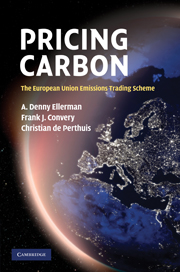Book contents
- Frontmatter
- Contents
- List of figures
- List of tables
- List of boxes
- List of appendices
- Frequently used abbreviations
- Preface
- 1 Introduction
- 2 Origins and development of the EU ETS
- 3 Allowance allocation
- 4 Effects of free allocation
- 5 Market development
- 6 Emissions abatement
- 7 Industrial competitiveness
- 8 Costs
- 9 Linkage and global implications
- 10 Conclusions
- Annex: The interaction between the EU ETS and European electricity markets
- Appendix A Sequence of events in the development of the EU ETS and Linking Directives
- Appendix B Data tables
- Bibliography
- Index
2 - Origins and development of the EU ETS
Published online by Cambridge University Press: 05 July 2011
- Frontmatter
- Contents
- List of figures
- List of tables
- List of boxes
- List of appendices
- Frequently used abbreviations
- Preface
- 1 Introduction
- 2 Origins and development of the EU ETS
- 3 Allowance allocation
- 4 Effects of free allocation
- 5 Market development
- 6 Emissions abatement
- 7 Industrial competitiveness
- 8 Costs
- 9 Linkage and global implications
- 10 Conclusions
- Annex: The interaction between the EU ETS and European electricity markets
- Appendix A Sequence of events in the development of the EU ETS and Linking Directives
- Appendix B Data tables
- Bibliography
- Index
Summary
Introduction
In a context of which Nietzsche would have approved, the European Union Emissions Trading Scheme grew out of failure. He admonishes us:
Examine the lives of the best and most fruitful people and peoples and ask yourselves whether a tree that is supposed to grow to a proud height can dispense with bad weather and storms; whether misfortune and external resistance, some kinds of hatred, jealousy, stubbornness, mistrust, hardness, avarice, and violence do not belong among the favourable conditions without which any great growth even of virtue is scarcely possible.
(Nietzsche, Beyond Good and Evil, 1886)The sapling that became EU ETS was a product of two failures. First, the European Commission failed in its initiative to introduce an effective EU-wide carbon energy tax in the 1990s. Second, the Commission fought unsuccessfully against the inclusion of trading as a flexible instrument in the Kyoto Protocol in 1997. This chapter explores how these apparent setbacks were followed by the successful creation of an EU-wide market in carbon dioxide.
Before delving into the political foundations of the EU ETS, some background knowledge will be useful. The first section of this chapter describes the political decision-making process within the European Union, in which power is shared between the Commission, the European Parliament and the Council of Ministers. The second section explores the academic and experiential platform that made the EU ETS possible, from the work of economists Coase, Dales, Crocker and Montgomery, to the American SO2 trading programme to intellectual development within Europe.
- Type
- Chapter
- Information
- Pricing CarbonThe European Union Emissions Trading Scheme, pp. 9 - 31Publisher: Cambridge University PressPrint publication year: 2010



